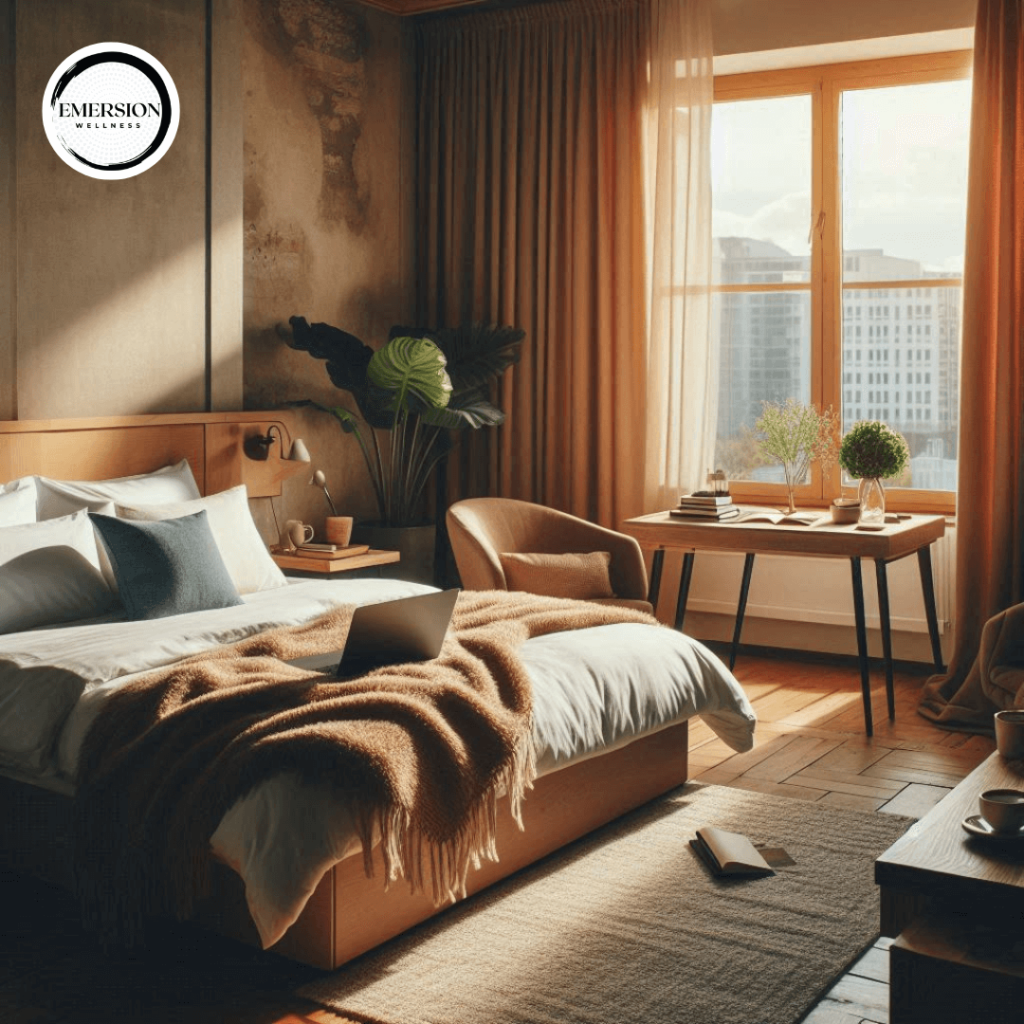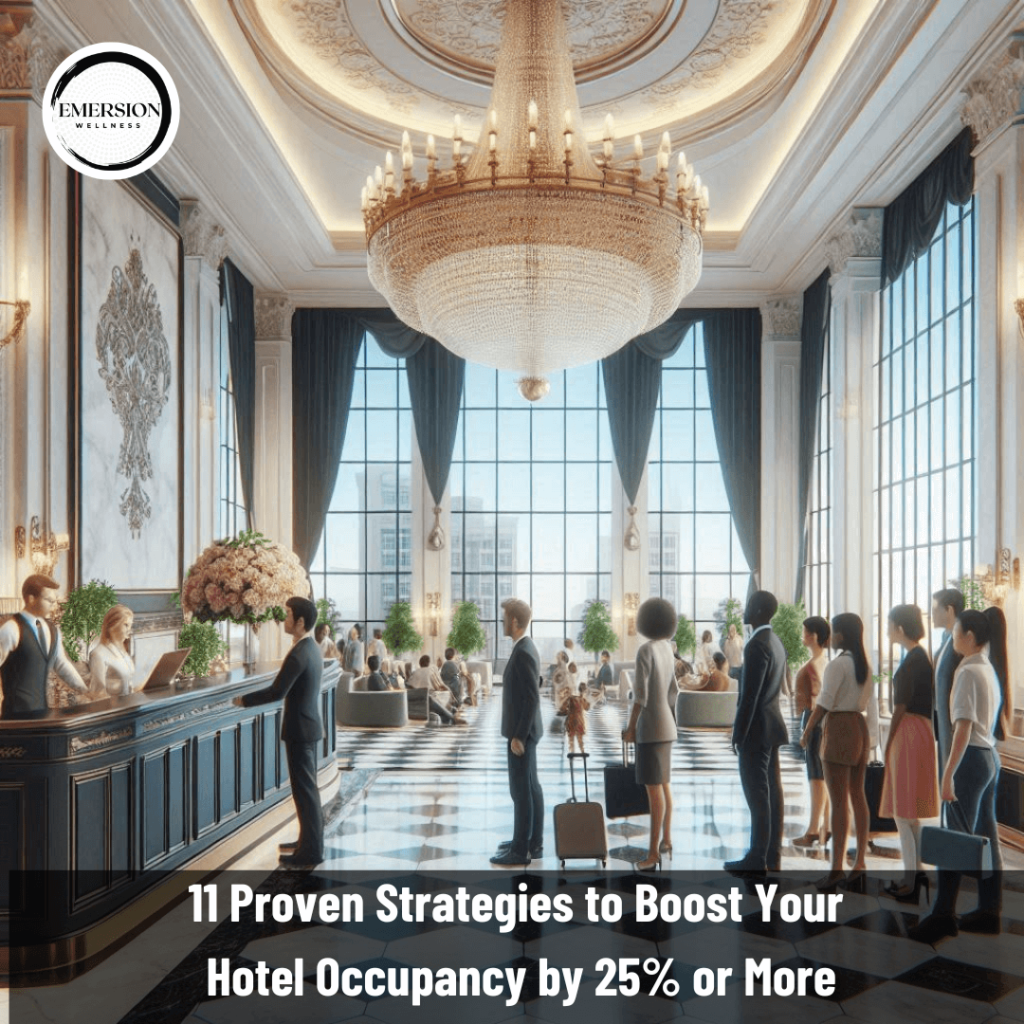In the fiercely competitive world of hospitality, a high hotel occupancy rate is the lifeblood of a successful business. Empty rooms translate to lost revenue, and let's face it, nobody wants that. But how can hotels consistently fill their rooms and keep those coveted occupancy rates climbing?
This comprehensive guide dives deep into 11 proven strategies that can significantly boost your hotel occupancy, boost revenue, and propel your hotel towards long-term financial success.
Critical Takeaways:
- The hotel occupancy rate refers to the percentage of rooms sold on a night.
- A healthy hotel occupancy rate is crucial for profitability, with the national average in the United States hovering around 66%—source: Statista [invalid URL removed].
- Implementing these 11 strategies can increase hotel occupancy by 25% or more, depending on your location, target audience, and market dynamics.
Understanding Hotel Occupancy: The Benchmark for Success
The hotel occupancy rate is a key performance indicator (KPI) measuring the percentage of rooms sold on a night. It's calculated by dividing the occupied rooms by the total available rooms and multiplying by 100. For instance, if a hotel with 100 rooms sells 70 rooms on a particular night, its occupancy rate would be 70%.
Maintaining a healthy hotel occupancy rate is essential for hotel profitability. While the national average in the United States is around 66%, this number can vary depending on location, seasonality, and hotel type. Luxury hotels in popular tourist destinations target occupancy rates closer to 80%, while budget hotels in less-frequented areas aim for 60%.
The key is understanding your specific market and setting realistic occupancy rate goals. However, the strategies outlined in this guide can be adapted to help any hotel increase hotel occupancy and achieve financial success regardless of location or target audience.
Unveiling the Power of Revenue Management: A Strategic Approach
Revenue management is the cornerstone of any successful strategy to increase hotel occupancy. It's a dynamic approach that goes beyond simply filling rooms. Revenue management focuses on selling the fitting room to the right guest at the right price through the right channel at the right time.
Here's a real-life example: Imagine a beach resort experiencing peak season with sky-high demand. Revenue management allows the hotel to adjust its pricing strategy accordingly, charging premium rates to capitalize on the influx of tourists. Conversely, during the off-season, the hotel can utilize revenue management to offer attractive discounts and promotions to incentivize bookings and increase hotel occupancy.
Effective revenue management involves:
- Demand forecasting: Accurately predicting future room demand using historical data, market trends, and competitor activity.
- Dynamic pricing: Adjusting room rates based on forecasted demand to maximize revenue throughout the year.
- Inventory management: Optimizing room allocation to balance the need to fill rooms with the opportunity to maximize revenue during peak periods.
- Distribution channel selection: Choosing the proper channels to reach the target audience and maximize exposure.
Leveraging Technology for Smarter Revenue Management
Technology plays a vital role in modern revenue management. Advanced software solutions streamline data analysis, forecasting, and pricing optimization, allowing hoteliers to make informed decisions quickly and efficiently. Here are some fundamental technology tools:
- Property Management Systems (PMS): These systems centralize guest information, reservation data, and room availability, providing a holistic view of hotel operations.
- Demand Management Systems (DMS): These sophisticated tools analyze historical data, market trends, and competitor pricing to generate highly accurate demand forecasts.
- Revenue Management Systems (RMS): These comprehensive systems integrate data from various sources, including PMS, DMS, and market intelligence tools, to recommend optimal pricing strategies for maximum revenue generation.
Building a Revenue Management Culture: Collaboration is Key
Revenue management is not just about technology and data; it's about fostering a culture within the hotel that embraces dynamic pricing and revenue optimization. Here's how to achieve this:
- Cross-departmental collaboration: Effective revenue management requires collaboration between sales, marketing, and reservations departments. Sharing data and insights ensures all teams are aligned towards achieving occupancy.
Optimizing Your Distribution Channels: Reaching the Right Guests
Choosing the proper distribution channels is crucial for maximizing exposure and attracting the target audience. A well-diversified distribution strategy can significantly increase hotel occupancy. Here are some key considerations:
- Direct Bookings: Encourage guests to book directly through the hotel website by offering exclusive deals and promotions. This lets you capture the highest profit margin and build stronger guest relationships.
- Online Travel Agencies (OTAs): While OTAs offer a wider reach, they often come with commission fees. Carefully evaluate the cost-effectiveness of different OTAs and prioritize those that align with your target audience.
- Metasearch Engines: Platforms like TripAdvisor and Google Hotels allow travellers to compare prices across different booking channels. Ensure your hotel is listed prominently on these platforms with accurate information and compelling descriptions.
- Strategic Partnerships: Collaboration with travel agencies, tour operators, and local businesses can attract new customer segments and generate bookings. For example, partnering with event organizers catering to conferences or weddings can fill rooms during traditionally slow periods.

Also, see 11 Creative Hotel Renovation Marketing Ideas to Boost Revenue (and Guest Satisfaction!)
Enhancing the Guest Experience: A Powerful Occupancy Booster
Guest experience is pivotal in attracting repeat business and positive online reviews, which can significantly increase hotel occupancy. Here are some strategies to enhance the guest experience:
- Personalized Service: Beyond the ordinary, providing customised touches that make guests feel valued. Remembering guest preferences, offering room upgrades (when available), and addressing special requests can create a memorable experience.
- Exceptional Amenities: Offer a range of amenities that cater to your target audience. This could include a swimming pool, fitness centre, spa services, or complimentary breakfast. High-quality amenities enhance the guest experience and encourage them to choose your hotel over competitors.
- Positive Online Reputation: Online reviews hold immense power in today's digital age. Encourage guests to leave positive reviews by providing exceptional service and addressing any negative feedback promptly and professionally. A solid online reputation builds trust and attracts new guests, leading to a higher hotel occupancy rate.
- Embrace Technology: Guests increasingly expect a seamless digital experience. Invest in user-friendly online booking systems, mobile check-in/check-out options, and self-service kiosks to streamline the guest journey and enhance convenience.
The Power of Packaging: Bundling Value to Attract Guests
Packaging deals that bundle your rooms with additional services or experiences can be a highly effective way to increase hotel occupancy. Here are some creative packaging ideas:
- Weekend Getaway Packages: Offer special packages that combine accommodation with meals, spa treatments, or local attraction tickets. This caters to leisure travellers seeking a relaxing escape.
- Romance Packages: Create packages specifically for couples, including champagne upon arrival, rose petals on the bed, and couples' massages. This strategy can attract guests celebrating anniversaries or special occasions.
- Business Travel Packages: Package your room rates with breakfast buffets, airport transportation, or access to business centres to cater to the needs of corporate travellers.
- Seasonal Packages: Create themed packages that capitalize on seasonal events or holidays. For example, offer a Halloween package with spooky decorations and themed activities or a festive holiday package with Christmas tree lighting ceremonies and special holiday menus.
Unlocking the Potential of Social Media: Engagement is Key
Social media platforms offer a powerful tool to connect with potential guests and increase hotel occupancy. Here are some strategies for effective social media marketing:
- Showcase Your Property: Use high-quality visuals to showcase your hotel's amenities, guest rooms, and surrounding locations. Post captivating photos and videos that entice potential guests to experience your unique offerings.
- Engage with Your Audience: Respond to comments and messages promptly, answer guest questions, and run interactive contests or polls to encourage engagement. Building a community around your hotel fosters brand loyalty and attracts new followers who might become future guests.
- Run Targeted Ads: Utilize social media advertising platforms to target specific demographics and interests with tailored promotions and offers. This allows you to reach your ideal guests and maximize the return on your advertising investment.
- Promote Guest-Generated Content: Encourage guests to share their experiences at your hotel by running photo contests or offering incentives for positive reviews. User-generated content adds authenticity and builds trust with potential guests, leading to a higher hotel occupancy rate.
Conclusion: A Multi-Faceted Approach to Occupancy Success
As you've seen, increasing hotel occupancy is not a one-size-fits-all solution. It requires a multi-faceted approach that combines strategic revenue management, exceptional guest experiences, creative marketing strategies, and a willingness to embrace innovation. By implementing the methods outlined in this guide and tailoring them to your specific hotel and target audience, you can significantly boost your occupancy rates and achieve long-term financial success.
Consider the following example: Imagine a boutique hotel in a historic city centre. Their target audience consists primarily of culture enthusiasts and business travellers. To increase hotel occupancy, they could:
- Implement a dynamic pricing strategy that adjusts rates based on local events and conferences, maximizing revenue during peak demand.
- Offer unique guest experiences like curated walking tours of historical sites or partnerships with local museums for exclusive guest discounts.
- Develop a solid social media presence showcasing the hotel's charming architecture and highlighting its proximity to cultural attractions.
- Partner with local businesses like restaurants and theatres to create unique packages that combine accommodation with dining experiences or show tickets.
This is just one example, and the possibilities are endless. The critical takeaway is to be proactive, creative, and data-driven in increasing hotel occupancy.
Unleash Your Hotel's Revenue Potential
Are you ready to unlock the hidden revenue potential of your hotel? At Emersion Wellness, we possess a proven track record of success in helping hotels achieve significant occupancy rate increases. Our team of hospitality experts offers a comprehensive suite of services designed to optimize your revenue generation strategies.
Here's how we can help:
- Revenue Management Audits: We'll assess your current revenue management practices and identify areas for improvement.
- Demand Forecasting and Pricing Strategy Development: Our data analysts will develop accurate demand forecasts and recommend optimal pricing strategies to maximize revenue throughout the year.
- Distribution Channel Optimization: We'll help you select the proper distribution channels and optimize your online presence to attract more guests.
- Guest Experience Enhancement: Our team will guide you in creating exceptional guest experiences that foster loyalty and positive online reviews.
- Marketing and Social Media Strategy Development: We'll help you develop a data-driven marketing strategy that leverages social media platforms to reach your target audience and drive bookings.
- The Power of Wellness: Consider our signature Emersion Wellness Weight Loss Program as a strategic tool to increase hotel occupancy. This program attracts health-conscious guests, leading to increased room bookings, spa service utilization, and food and beverage sales.
Contact Emersion Wellness today and let us help you transform your hotel's occupancy rates and profitability. Don't miss out on the opportunity to unlock your hotel's true revenue potential!
FAQs About Increasing Hotel Occupancy
Here are ten frequently asked questions about increasing hotel occupancy, along with detailed answers to help you gain a deeper understanding:
1. What is the difference between occupancy rate and revenue per available room (RevPAR)?
Occupancy rate measures the percentage of rooms sold on a given night, while RevPAR is a metric that combines occupancy rate with ADR (Average Daily Rate). RevPAR provides a more holistic view of a hotel's room revenue generation per night. For instance, a hotel with a high occupancy rate but a low ADR might have a lower RevPAR than a hotel with a slightly lower occupancy rate but a higher ADR.
2. How can I overcome seasonality and attract guests during off-peak periods?
Seasonality is a challenge for many hotels. Here are some strategies to combat it:
- Offer attractive discounts and promotions during off-peak periods to incentivize bookings.
- Develop targeted marketing campaigns highlighting the unique advantages of visiting during the off-season, such as lower prices, fewer crowds, and a more relaxed atmosphere.
- Partner with local businesses to create unique packages that combine accommodation with off-season activities or events.
3. What are some practical ways to encourage repeat business?
- Implement a loyalty program that rewards guests for returning stays.
- Personalize the guest experience by remembering guest preferences and offering special touches.
- Collect guest feedback through surveys or emails to continuously improve your offerings.
- Stay connected with past guests through email marketing campaigns and exclusive promotions.
4. Is it necessary to offer my rooms on all significant OTAs?
Not necessarily. While OTAs offer a wider reach, they often come with commission fees that can affect your profits. Carefully evaluate the cost-effectiveness of each OTA and prioritize those that align with your target audience and generate the highest return on investment.
5. How much should I spend on marketing to increase hotel occupancy?
The ideal marketing budget will vary depending on your hotel's size, location, and target audience. However, allocating around 10-15% of your total revenue to marketing initiatives is a good rule of thumb. The key is to track your marketing performance and adjust your budget allocation based on different marketing channels' return on investment (ROI).
6. What legal considerations should I know when running hotel promotions?
Ensure your promotions are communicated and abide by all advertising regulations. Avoid misleading language or deceptive pricing practices. Be transparent about any blackout dates or restrictions that apply to your promotions.
7. How can I deal with negative online reviews?
Negative online reviews can happen, but how you respond to them is crucial. Address negative feedback promptly and professionally. Acknowledge the guest's concerns and outline the steps you're taking to address the issue. Thank the guest for their feedback and use it as a learning opportunity to improve your services.
8. What are some additional strategies to improve the guest experience?
- Offer exceptional customer service: Train your staff to be friendly, helpful, and attentive to guest needs.
- Maintain a clean and well-maintained property: Ensure your hotel is clean, comfortable, and inviting for guests.
- Provide thoughtful amenities: Offer a variety of amenities that cater to your target audience, such as high-speed Wi-Fi, complimentary breakfast options, or comfortable bathrobes and slippers.
- Go the extra mile: Small gestures of hospitality can make a big difference. Offer guests a complimentary water bottle upon arrival or surprise them with a small treat in their room.
9. Is investing in revenue management software worth it?
Absolutely! Revenue management software can be a game-changer for hotels. These sophisticated tools automate data analysis, forecasting, and pricing optimization, allowing you to make informed decisions that maximize revenue and occupancy rates. While the initial investment might seem daunting, the long-term return on investment can be significant.
By implementing the strategies outlined in this guide and addressing the questions explored in this FAQ section, you can be well on your way to increasing hotel occupancy and achieving long-term success in the competitive hospitality industry. Remember, Emersion Wellness is here to partner with you every step of the way. Contact us today and let our hospitality experts help you unlock the hidden revenue potential of your hotel.

I'm Nathan Baws, a nutrition nerd, exercise and weight loss expert, and an unwavering advocate for good health. As the founder of Emersion Wellness, I'm passionate about crafting Seamless Weight Loss Programs to supercharge hotel revenue and transform lives. We've pioneered the World's First Plug & Play Weight Loss Programs for top hotels and resorts, sparking a wellness revolution. Beyond my professional journey, you'll often find me hiking, swimming, and riding the waves, embracing every moment in nature. Join me on this exhilarating journey towards diet, health and wellness.

